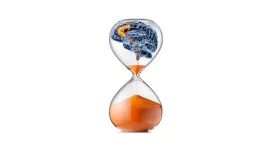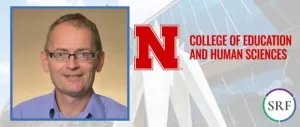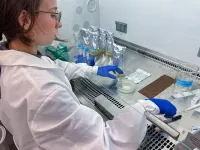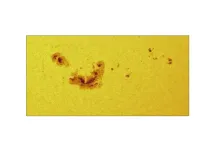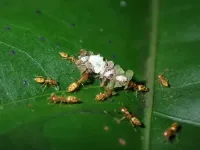(Press-News.org) Ever hear the old adage that time flies when you’re having fun? A new study by a team of UNLV researchers suggests that there’s a lot of truth to the trope.
Many people think of their brains as being intrinsically synced to the man-made clocks on their electronic devices, counting time in very specific, minute-by-minute increments. But the study, published this month in the latest issue of the peer-reviewed Cell Press journal Current Biology, showed that our brains don’t work that way.
By analyzing changes in brain activity patterns, the research team found that we perceive the passage of time based on the number of experiences we have — not some kind of internal clock. What’s more, increasing speed or output during an activity appears to affect how our brains perceive time.
“We tell time in our own experience by things we do, things that happen to us,” said James Hyman, a UNLV associate professor of psychology and the study’s senior author. “When we’re still and we’re bored, time goes very slowly because we’re not doing anything or nothing is happening. On the contrary, when a lot of events happen, each one of those activities is advancing our brains forward. And if this is how our brains objectively tell time, then the more that we do and the more that happens to us, the faster time goes.”
Methodology and Findings
The findings are based on analysis of activity in the anterior cingulate cortex (ACC), a portion of the brain important for monitoring activity and tracking experiences. To do this, rodents were tasked with using their noses to respond to a prompt 200 times.
Scientists already knew that brain patterns are similar, but slightly different, each time you do a repetitive motion, so they set out to answer: Is it possible to detect whether these slight differences in brain pattern changes correspond with doing the first versus 200th motion in series? And does the amount of time it takes to complete a series of motions impact brain wave activity?
By comparing pattern changes throughout the course of the task, researchers observed that there are indeed detectable changes in brain activity that occur as one moves from the beginning to middle to end of carrying out a task. And regardless of how slowly or quickly the animals moved, the brain patterns followed the same path. The patterns were consistent when researchers applied a machine learning-based mathematical model to predict the flow of brain activity, bolstering evidence that it’s experiences — not time, or a prescribed number of minutes, as you would measure it on a clock — that produce changes in our neurons’ activity patterns.
Hyman drove home the crux of the findings by sharing an anecdote of two factory workers tasked with making 100 widgets during their shift, with one worker completing the task in 30 minutes and the other in 90 minutes.
“The length of time it took to complete the task didn’t impact the brain patterns. The brain is not a clock; it acts like a counter,” Hyman explained. “Our brains register a vibe, a feeling about time. ...And what that means for our workers making widgets is that you can tell the difference between making widget No. 85 and widget No. 60, but not necessarily between No. 85 and No. 88.”
But exactly "how” does the brain count? Researchers discovered that as the brain progresses through a task involving a series of motions, various small groups of firing cells begin to collaborate — essentially passing off the task to a different group of neurons every few repetitions, similar to runners passing the baton in a relay race.
“So, the cells are working together and over time randomly align to get the job done: one cell will take a few tasks and then another takes a few tasks,” Hyman said. “The cells are tracking motions and, thus, chunks of activities and time over the course of the task.”
And the study’s findings about our brains’ perception of time applies to activities-based actions other than physical motions too.
“This is the part of the brain we use for tracking something like a conversation through dinner,” Hyman said. “Think of the flow of conversation and you can recall things earlier and later in the dinner. But to pick apart one sentence from the next in your memory, it’s impossible. But you know you talked about one topic at the start, another topic during dessert, and another at the end.”
By observing the rodents who worked quickly, scientists also concluded that keeping up a good pace helps influence time perception: “The more we do, the faster time moves. They say that time flies when you’re having fun. As opposed to having fun, maybe it should be ‘time flies when you’re doing a lot’."
Takeaways
While there’s already a wealth of information on brain processes over very short time scales of less than a second, Hyman said that the UNLV study is groundbreaking in its examination of brain patterns and perception of time over a span of just a few minutes to hours – “which is how we live much of our life: one hour at a time. “
“This is among the first studies looking at behavioral time scales in this particular part of the brain called the ACC, which we know is so important for our behavior and our emotions,” Hyman said.
The ACC is implicated in most psychiatric and neurodegenerative disorders, and is a concentration area for mood disorders, PTSD, addiction, and anxiety. ACC function is also central to various dementias including Alzheimer’s disease, which is characterized by distortions in time. The ACC has long been linked to helping humans with sequencing events or tasks such as following recipes, and the research team speculates that their findings about time perception might fall within this realm.
While the findings are a breakthrough, more research is needed. Still, Hyman said, the preliminary findings posit some potentially helpful tidbits about time perception and its likely connection to memory processes for everyday citizens' daily lives. For example, researchers speculate that it could lend insights for navigating things like school assignments or even breakups.
“If we want to remember something, we may want to slow down by studying in short bouts and take time before engaging in the next activity. Give yourself quiet times to not move,” Hyman said. “Conversely, if you want to move on from something quickly, get involved in an activity right away.”
Hyman said there’s also a huge relationship between the ACC, emotion, and cognition. Thinking of the brain as a physical entity that one can take ownership over might help us control our subjective experiences.
“When things move faster, we tend to think it’s more fun — or sometimes overwhelming. But we don’t need to think of it as being a purely psychological experience, as fun or overwhelming; rather, if you view it as a physical process, it can be helpful,” he said. “If it’s overwhelming, slow down or if you’re bored, add activities. People already do this, but it’s empowering to know it’s a way to work your own mental health, since our brains are working like this already.”
About the Study
“Temporal information in the anterior cingulate cortex relates to accumulated experiences” was published July 8, 2024 in Current Biology. In addition to Hyman, researchers included: UNLV graduate students Ryan A. Wirt and Talha K. Soluoku, and medical student Ryan M. Ricci; and Jeremy K. Seamans of the University of British Columbia.
END
Good timing: UNLV study unravels how our brains track time
It’s not how many minutes, but how much fun, says new neuroscience research.
2024-07-19
ELSE PRESS RELEASES FROM THIS DATE:
Positive and negative impacts of interfacial hydrogen bonds on photocatalytic hydrogen evolution
2024-07-19
Photocatalytic hydrogen evolution from water is a key technology for achieving sustainable hydrogen production. However, the direct impact of the microscopic structure of interfacial water molecules on photocatalytic reactivity remains unexplored. In this study, the crucial roles of interfacial hydrogen bond structure and dynamics, as well as the optimal interfacial water environment for promoting H2 evolution were uncovered. These findings provide molecular-level insights that can guide the design of interfacial water conditions to enhance photocatalytic performance.
Hydrogen production via photocatalytic water splitting is a sustainable ...
SynGAP Research Fund (SRF) continues support for exosome research for SYNGAP1-Related Disorders (SRD) in the lab of Professor Janos Zempleni of the University of Nebraska-Lincoln
2024-07-19
Mill Valley, CA – July 10, 2024 – The SynGAP Research Fund 501(c)(3) announces a $190,636 grant, for work to be done in 2024 and 2025, to Professor Janos Zempleni, PhD of the University of Nebraska-Lincoln, to establish data required for regulatory approval for his novel treatment using an engineered version of naturally-occurring particles called exosomes. His first grant from SRF established the engineered changes required to accumulate exosomes in the brain. SRF is pleased to support the continued development of a non-invasive and targeted delivery system for therapeutics ...
Food research fellowships funded for scientists in 6 countries
2024-07-19
DALLAS, July 18, 2024 — Diet-related diseases account for 1 in 5 deaths around the world[1] and unsustainable industrial agricultural practices threaten to compromise the health of the planet.[2] While emerging science expands our knowledge of food composition, society still understands little about the tens of thousands of components found in food.
The American Heart Association is facilitating a new research fellowship program from the Periodic Table of Food Initiative (PTFI) with support from The Rockefeller Foundation. The program, called Good Food Fellows, aims to train a new ...
Illinois studies explore converting wastewater to fertilizer with fungal treatment
2024-07-19
URBANA, Ill. – Creating fertilizers from organic waste can help reduce the consumption of fossil fuels and promote sustainable production. One way of doing this is through hydrothermal liquefaction (HTL), which converts biomass into biocrude oil through a high-temperature, high-pressure process. Two studies from the University of Illinois Urbana-Champaign explore the use of a fungal treatment to convert the leftover wastewater into fertilizer for agricultural crops.
“HTL uses wet biomass from organic sources such as swine manure or food waste. The process yields wastewater, called hydrothermal liquefaction aqueous phase (HTL-AP), which is usually discarded. We ...
Time-lapse imaging for embryo selection in IVF does not improve the odds of live birth compared with conventional methods, according to largest study of its kind
2024-07-19
There is no difference in live birth rates between time-lapse imaging and other standard approaches used in in-vitro fertilisation (IVF) for embryo incubation and selection prior to implantation, according to the results of the largest trial of its kind.
The randomised controlled trial looked at IVF outcomes in the UK and Hong Kong. The results, published today in The Lancet, provide much-needed evidence that using time-lapse imaging (TLI) does not improve treatment outcomes for someone undergoing fertility treatment.
Time-lapse imaging is a technique ...
Early riser! The Sun is already starting its next solar cycle – despite being halfway through its current one
2024-07-19
Early riser! The Sun is already starting its next solar cycle – despite being halfway through its current one
Royal Astronomical Society press release
RAS PR 24/21 (NAM 7)
Embargoed until 00:01 BST on Friday 19 July 2024
The first rumblings of the Sun's next 11-year solar cycle have been detected in sound waves inside our home star – even though it is only halfway through its current one.
This existing cycle is now at its peak, or 'solar maximum' - which is when the Sun’s magnetic field flips and its poles swap places - until mid-2025.
It affects ...
Oakland hospital building is approved for construction
2024-07-19
Subscribe to UCSF News
Note to Editors: Photos and renderings are available in our Media Kit
UC Regents sign off on $1.5 billion project to construct a new hospital building at UCSF Benioff Children’s Hospital Oakland, securing the future of world-class pediatric facilities in the East Bay.
UCSF Benioff Children’s Hospitals has received final approval on a $1.49 billion hospital building on its Oakland campus that will provide a state-of-the-art, child-centered medical facility for families across the Bay Area. The proposal was approved ...
Rice’s Emilia Morosan awarded prestigious Vannevar Bush Faculty Fellowship
2024-07-18
Rice University’s Emilia Morosan has been selected as one of 11 scientists and engineers for the 2024 Vannevar Bush Faculty Fellowship (VBFF) to support her work on correlated topological materials. The fellowship is the Department of Defense’s (DoD) most prestigious single-investigator award and supports groundbreaking basic research with the potential to transform various fields.
The VBFF, a five-year fellowship with up to $3 million in funding, encourages innovative ideas where researcher creativity intersects with the unknown. Vannevar Bush Fellows represent a cadre of experts who provide invaluable direction to the DoD ...
DOE announces $52 million for small business research and development grants
2024-07-18
WASHINGTON, D.C.—In support of President Biden’s Investing in America agenda, the U.S. Department of Energy (DOE) today announced awards totaling $52 million for a broad range of small businesses in 39 states. The projects will work to solve a wide range of problems—from cybersecurity for electric vehicle charging infrastructure to new ways to detect radiation threats and new ways to manufacture lithium metal for batteries.
“Since Day One, the Biden-Harris Administration has supported small businesses, prompting record ...
Of ants and trees: ‘Evolutionary déjà’ in the tropical rainforest
2024-07-18
Ants are famous for their regimented and complex social behaviors. In the tropics, they are also famous for forming mutualisms with plants. Certain species of trees have conspicuous hollow swellings that house ants, often feeding the ants with specialized ant food. In return, the ants are pugnacious bodyguards, swarming out to aggressively defend the plant against enemies. Scientists have observed these mutualisms for centuries, but an enduring question is how these intriguing interactions evolved in the first place.
That remains a mystery, but new research led by University ...
LAST 30 PRESS RELEASES:
How the parasite that ‘gave up sex’ found more hosts – and why its victory won’t last
When is it time to jump? The boiling frog problem of AI use in physics education
Twitter data reveals partisan divide in understanding why pollen season's getting worse
AI is quick but risky for updating old software
Revolutionizing biosecurity: new multi-omics framework to transform invasive species management
From ancient herb to modern medicine: new review unveils the multi-targeted healing potential of Borago officinalis
Building a global scientific community: Biological Diversity Journal announces dual recruitment of Editorial Board and Youth Editorial Board members
Microbes that break down antibiotics help protect ecosystems under drug pollution
Smart biochar that remembers pollutants offers a new way to clean water and recycle biomass
Rice genes matter more than domestication in shaping plant microbiomes
Ticking time bomb: Some farmers report as many as 70 tick encounters over a 6-month period
Turning garden and crop waste into plastics
Scientists discover ‘platypus galaxies’ in the early universe
Seeing thyroid cancer in a new light: when AI meets label-free imaging in the operating room
Neutrophil-to-lymphocyte ratio may aid risk stratification in depressive disorder
2026 Seismological Society of America Annual Meeting
AI-powered ECG analysis offers promising path for early detection of chronic obstructive pulmonary disease, says Mount Sinai researchers
GIMM uncovers flaws in lab-grown heart cells and paves the way for improved treatments
Cracking the evolutionary code of sleep
Medications could help the aging brain cope with surgery, memory impairment
Back pain linked to worse sleep years later in men over 65, according to study
CDC urges ‘shared decision-making’ on some childhood vaccines; many unclear about what that means
New research finds that an ‘equal treatment’ approach to economic opportunity advertising can backfire
Researchers create shape-shifting, self-navigating microparticles
Science army mobilizes to map US soil microbiome
Researchers develop new tools to turn grain crops into biosensors
Do supervised consumption sites bring increased crime? Study suggests that’s a myth
New mass spec innovation could transform research
Maternal nativity, race, and ethnicity and infant mortality in the US
Migration-related trauma among asylum seekers exposed to the migrant protection protocols
[Press-News.org] Good timing: UNLV study unravels how our brains track timeIt’s not how many minutes, but how much fun, says new neuroscience research.
